Suture Materials
1/42
There's no tags or description
Looks like no tags are added yet.
Name | Mastery | Learn | Test | Matching | Spaced |
|---|
No study sessions yet.
43 Terms
Absorbable sutures do not typically require ________. They provide temporary ______ to an incision or wound until the apposed tissue can withstand the body's own _______ stresses. They are broken down by various processes including ________, and __________ __________ ___________. The ____ ________ are then absorbed. Some are absorbed______ than others.
Absorbable sutures do not typically require removal. They provide temporary strength to an incision or wound until the apposed tissue can withstand the body's own mechanical stresses. They are broken down by various processes including hydrolysis and proteolytic enzyme degradation. The bi-products are then absorbed. Some are absorbed faster than others.
Non-absorbable sutures are usually __________ post operatively. However, in some more rare applications, they are left in place and could be considered _______. They are made of non __________ materials and if left in place, they are _________ by scar tissue. They can ______ over time, but are not absorbed.
Non-absorbably sutures are usually removed post operatively. However, in some more rare applications, they are left in place and could be considered implants. They are made of non-biodegradable materials and if left in place, they are encapsulated by scar tissue. They can degrade over time but are not absorbed.
Monofilament sutures are composed of a _____ thread which allows_____ passage through tissue and may _____ chances of bacterial growth on the suture material compared to ______ suture materials.
Monofilament sutures are composed of a single thread which allows easy passage through tissues and may decrease chances of bacterial growth on the suture material compared to braided suture materials.
Multifilament sutures consist of ________ small threads twisted or braided together. This provides greater strength (when compared to _______ of the same size), but at the cost of ________ potential for _______ with bacteria lodging in the ___________of the material.
Multifilament sutures consist of several small threads twisted or braided together. This provides greater strength (when compared to monofilament of the same size), but at the cost of increased potential for infection with bacteria lodging in the crevices of the material.
What are the Multifilament absorbable sutures?
Vicryl, Chromic gut, Dexon
What are the 5 Monofilament absorbable sutures?
Monocryl, PDS, biosyn, Caprosyn, Maxon
What are the 2 Multifilament Non-Absorbable sutures?
Silk, Ethi-bond/Ti-Cron
What are the 5 Monofilament Non-Absorbable sutures?
Ethilon/Monosof, Prolene/Surgipro, Supramid, Novafil, Stainless Steel
Cat gut can be found ________ or treated with _______ salt solution. Chromic gut avoids absorption _________ than plain. (___ to ____ vs. ___ for plain).
Chromic gut is derived from ______ or ______ fibrous layers of intestine, this natural ________ suture has alot of __________ and is easier to handle when ________.
Cat Gut is ____ Suture.
Cat gut can be found plain or treated with chromic salt solution. Chromic gut avoids absorption longer than plain (10-14 days verses 7 for plain). Chromic gut is derived from serosa or submucosal fibrous layers of intestine, this natural monofilament suture has alot of memory and is easier to handle when moist.
Cat Gut is absorbable suture.
Monocryl is a __________ ______ made from a copolymer of glycolide and epsilon- caprolactone. These sutures have a tensile strength of ____% after two weeks. This suture is _______ to handle but does not have much ________.
Monocryl is _______ suture.
Monocryl is a monofilament synthetic made from a copolymer of glycolide and episol-caprolactone. These sutures have a tensile strength of 30% after two weeks. This suture is easy to handle but does not have much memory.
Monocryl is absorbable suture.
PDS- This suture is made from _______ and retains ____% strength after two weeks and ____ after 8 weeks. It has a significant amount of _______ and it remains present in ____ much ______ than the timeline for decrease in strength would suggest.
PDS is _______ suture.
PDS- This suture is made from polyester and retains 80% strength after two weeks and 44% after 8 weeks. It has a significant amount of memory and it remains present in tissue much longer than the timeline for decrease in strength would suggest.
PDS is absorbable suture.
Vicryl- This __________ _______ suture holds ____% strength for __ weeks in tissue and is completely absorbed in ---------- days. It is made from polyglycolic acid. Vicryl has literally ___ memory but for larger sizes, the ____ _____ is relatively poor. It is also sold as an ______ suture, coated in _______.
Vicryl is _______ suture.
This synthetic braided suture holds 65% strength for 2 weeks in tissue and is completely absorbed in 56-70 days. It is made from polyglycolic acid. Vicryl has literally no memory but for larger sizes, the knot security is relatively poor. It is also sold as an antibacterial suture coated in triclosan.
Vicryl is absorbable suture.
A. GI anastomoses in a calf or goat
B. Intradermal closure in a horse
C. Subcutaneous layer apposition in a horse if smaller than a size 0
D. Closure of a fascial later; size unknown so in a cat if <2-0 in a cow if about size 2
E. GI anastomosis or enterotomy closure in a horse
F. Opthalmic applications
What would you use these sutures for?

A, D, E
Which of them have a tapered needle?
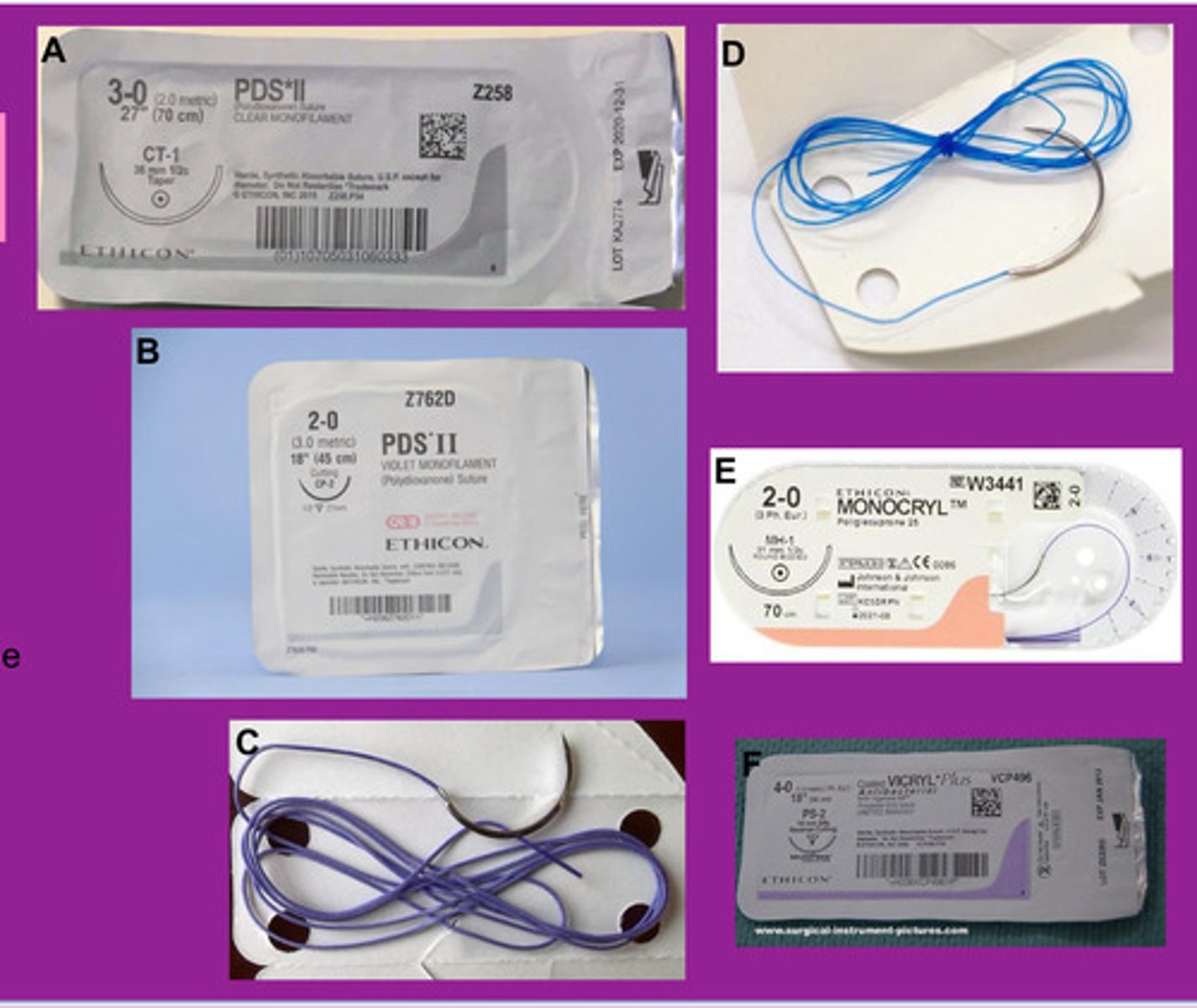
None!
Which of them have a conventional cutting needle?
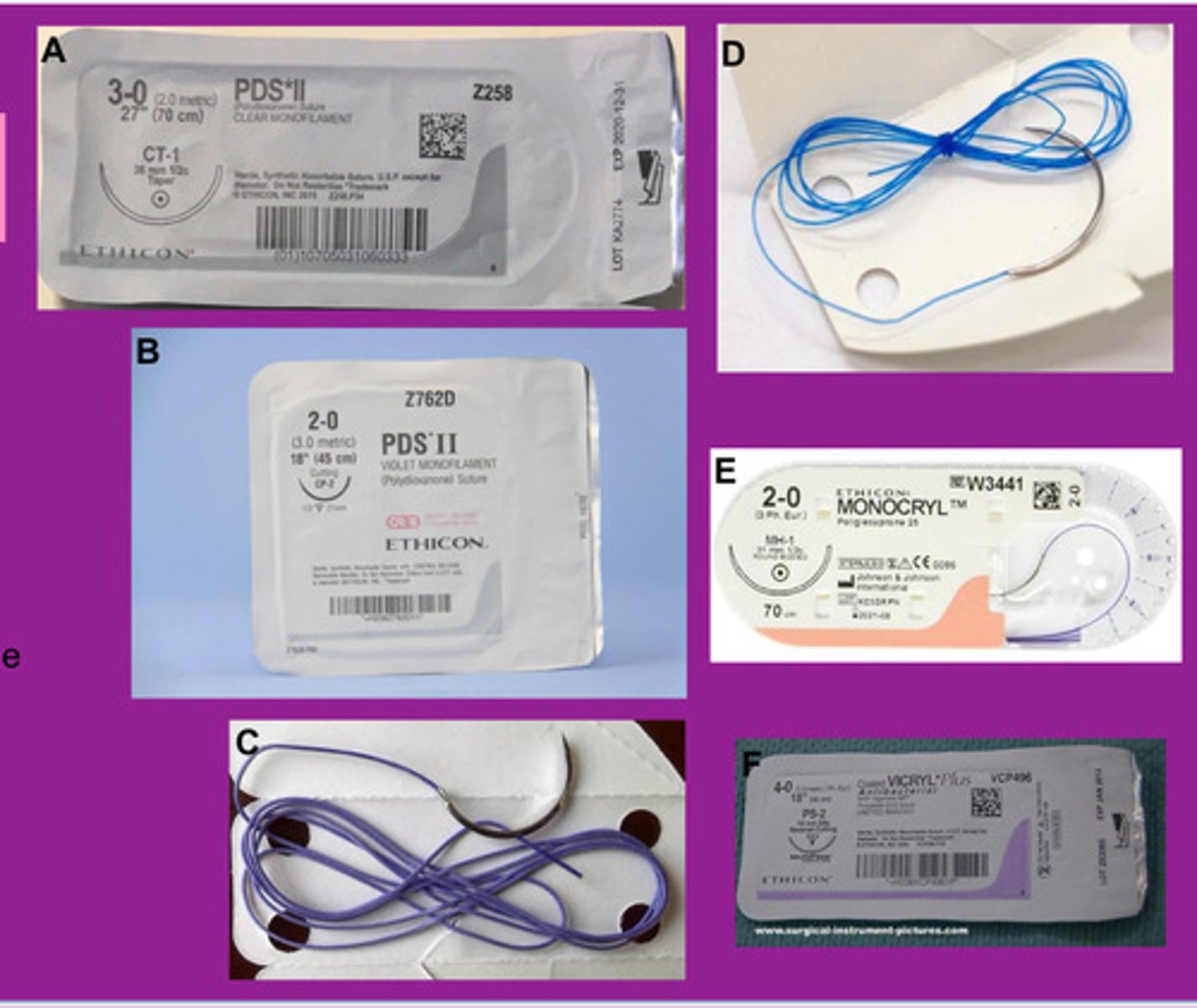
B, C, F
Which of them have a reverse cutting needle?
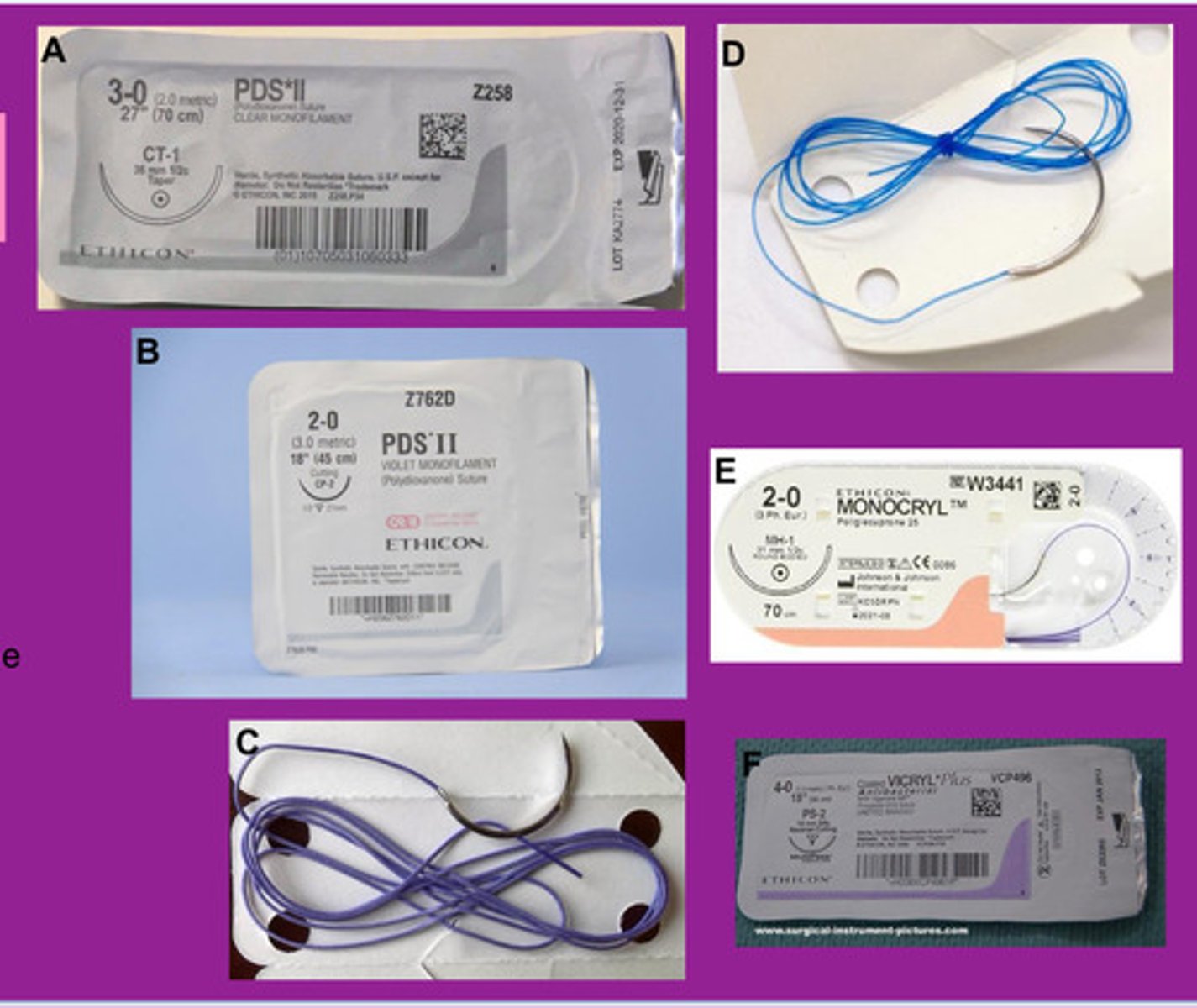
C, F
Which of them are braided?
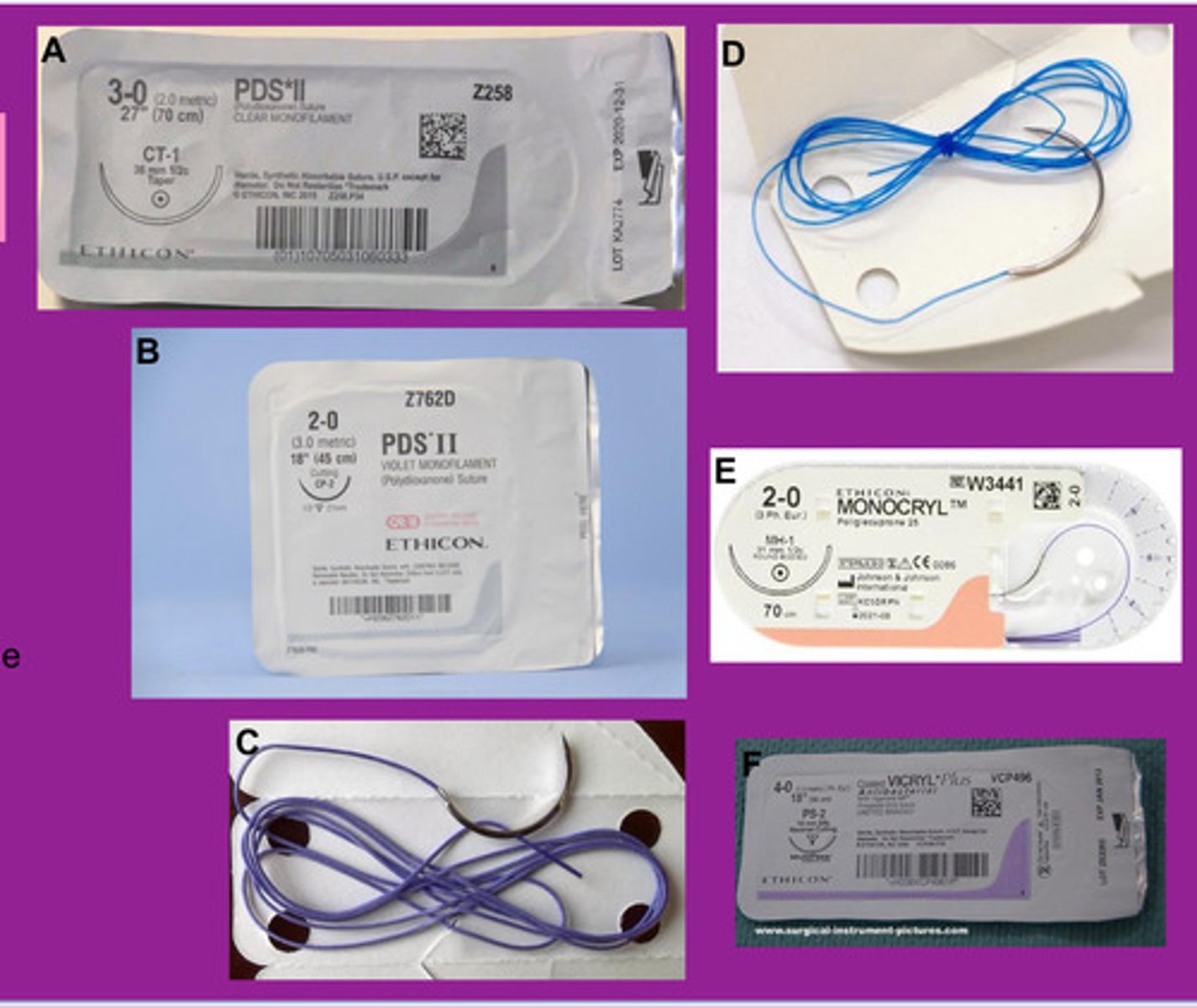
A, B, D, E
Which of them are monofilaments?

Ethilon is a ______ ________ _______ suture, usually black in color. Nylon sutures are very ______ have relatively little ______ and ________ knot security. Ethilon sutures are commonly used to appose _____ when sutures can be removed 10-14 days post suture placement.
Ethilon is a _________ suture.
Ethilon is a synthetic monofilament nylon suture, usually black in color. Nylon sutures are very smooth and relatively little memory with good knot security. Ethilon sutures are commonly used to appose skin when sutures can be removed 10-14 days post suture placement.
Ethilon is a non-absorbable suture.
Prolene is a __________ suture made of polypropylene. It is intended to be __________ and long __________ . It causes very little tisue __________ and thus is very useful to suture skin in __________ wounds.
Prolene has alot of __________ which makes it sometimes __________ to handle (especially in __________ sizes) and it is more expensive compared to __________
Prolene is a ____________ suture.
Prolene is a monofilament suture made of polypropylene. It is intended to be durable and long lasting. It causes very little tisue reaction and thus is very useful to suture skin in contaminated wounds.
Prolene has alot of memory which makes it sometimes hard to handle (especially in larger sizes) and it is more expensive compared to nylon.
Prolene is a non-absorbable suture.
Supramid is a ____________ suture made of polyamide. At larger sizes it is called a pseudo-____________ , since it is composed of a core and a coating of different polyamides. It is used most commonly for ____________ ____________ in ____________ animals or to secure a ____________ or ____________ bandages in ____________ animals.
Supramid is a ____________ suture.
Supramid is a synthetic suture made of polyamide. At larger sizes it is called a pseudo-monafilament, since it is composed of a core and a coating of different polyamides. It is used most commonly for skin closure in production animals or to secure a stent or bolster bandages in large animals.
Supramid is a non-absorbable suture.
Silk suture is a _________ fibroin from Brombyx mori. It is treated with _________ to give a _________ surface and _________ . Silk is used in _________ procedures. It has fallen out of favor among surgeons due to its _________ tissue reactivity.
Silk suture is a braided fibroin from Brombyx mori. It is treated with silicone to give a smooth surface and strength. Silk is used in cardiovascular procedures. It has fallen out of favor among surgeons due to its high tissue reactivity.
What would you use these sutures for?
A. skin closure in a kitten (not intradermal!)
B. Ligation of a small blood vessel in a pig
C. Stay suture in a bladder
D. GI anastomosis or enterotomy closure in a horse
E. Skin in a mouse (not intradermal!)
F. Skin in a rat (not intradermal!)

Which of them have a taper needle?
C, D, F
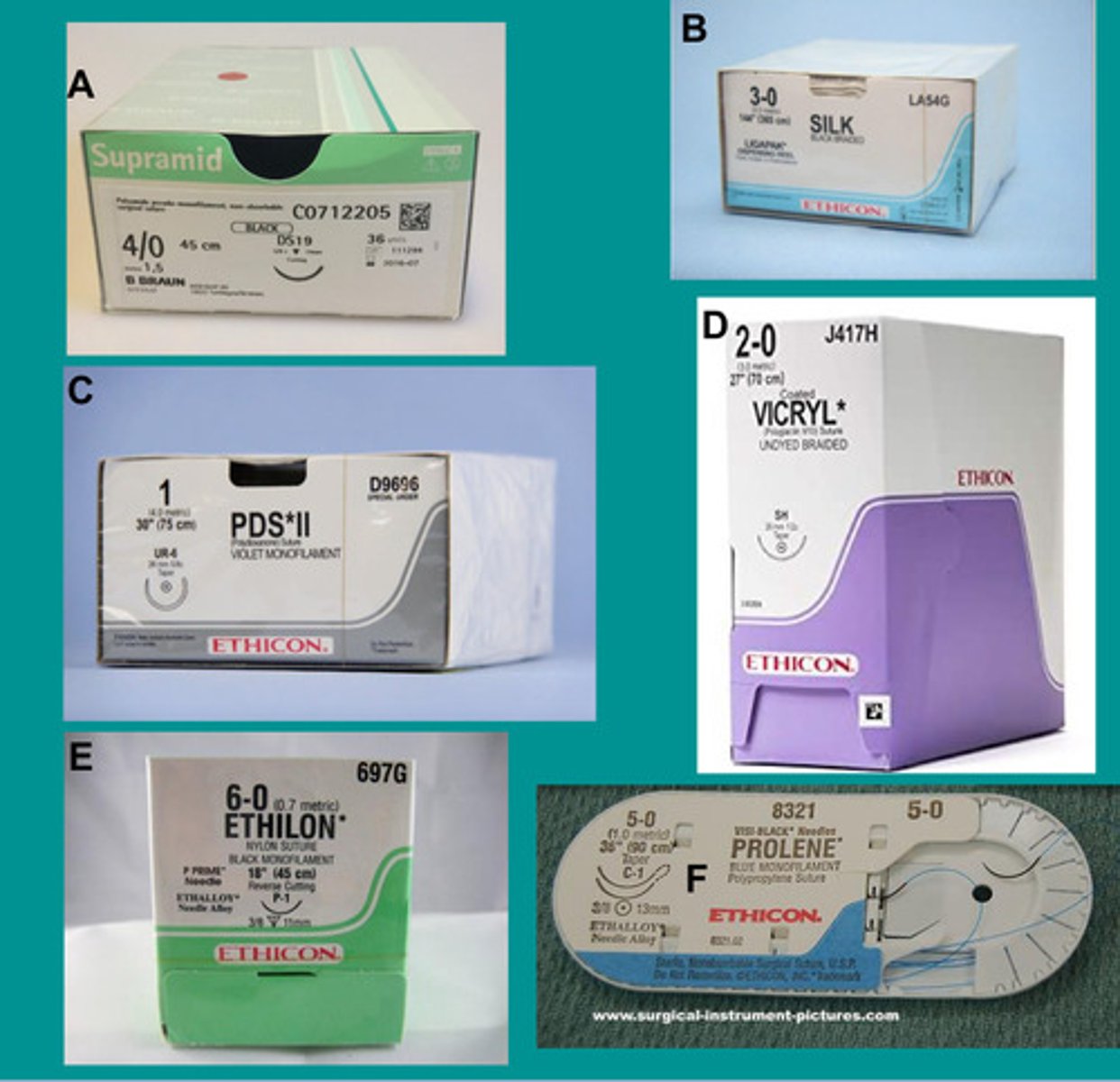
Which of them have a conventional cutting needle?
None

Which of them have a reverse cutting needle?
A, E
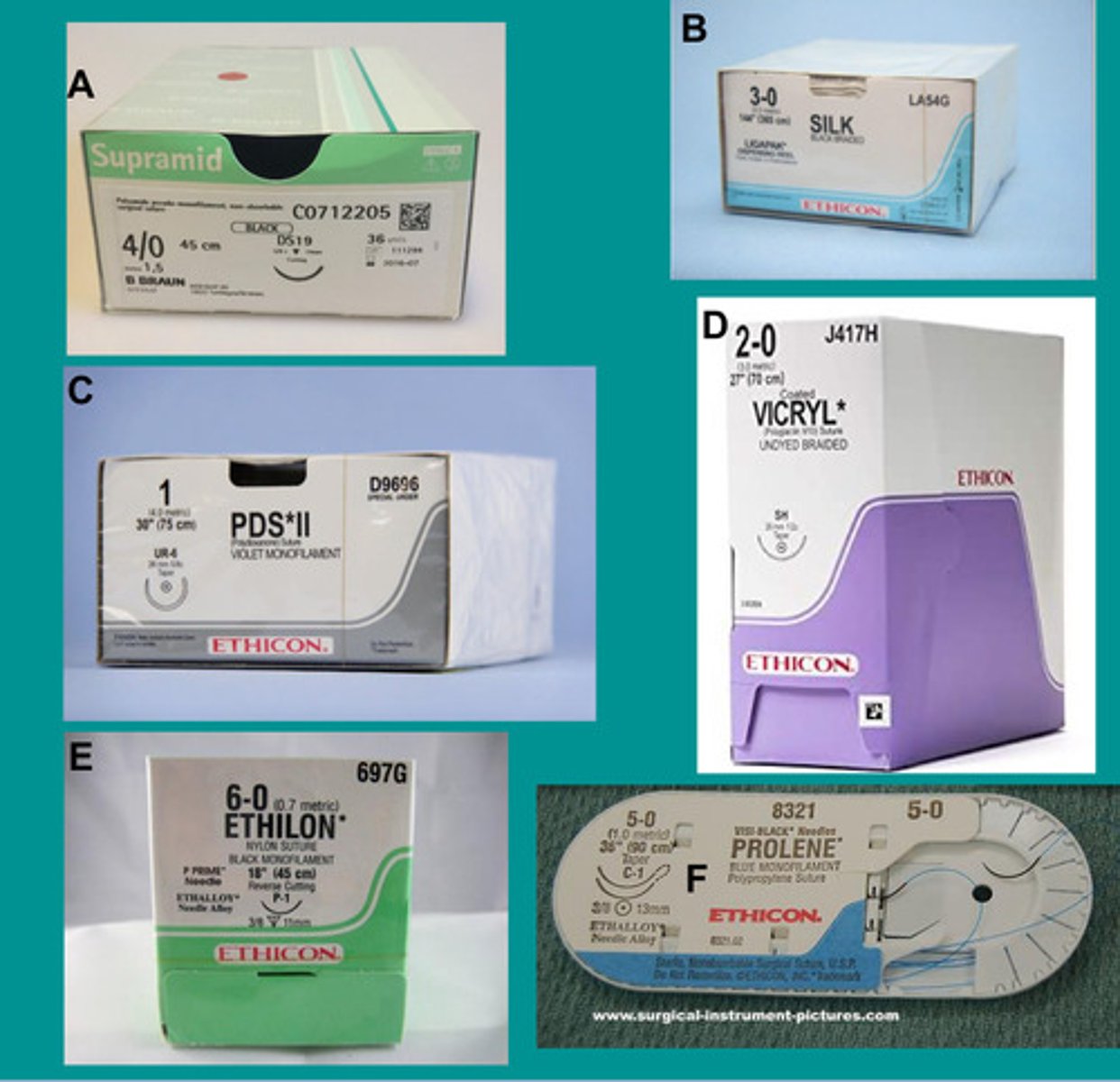
Which of them are braided?
B, D

Which of them are monofilaments?
A, C, E, F
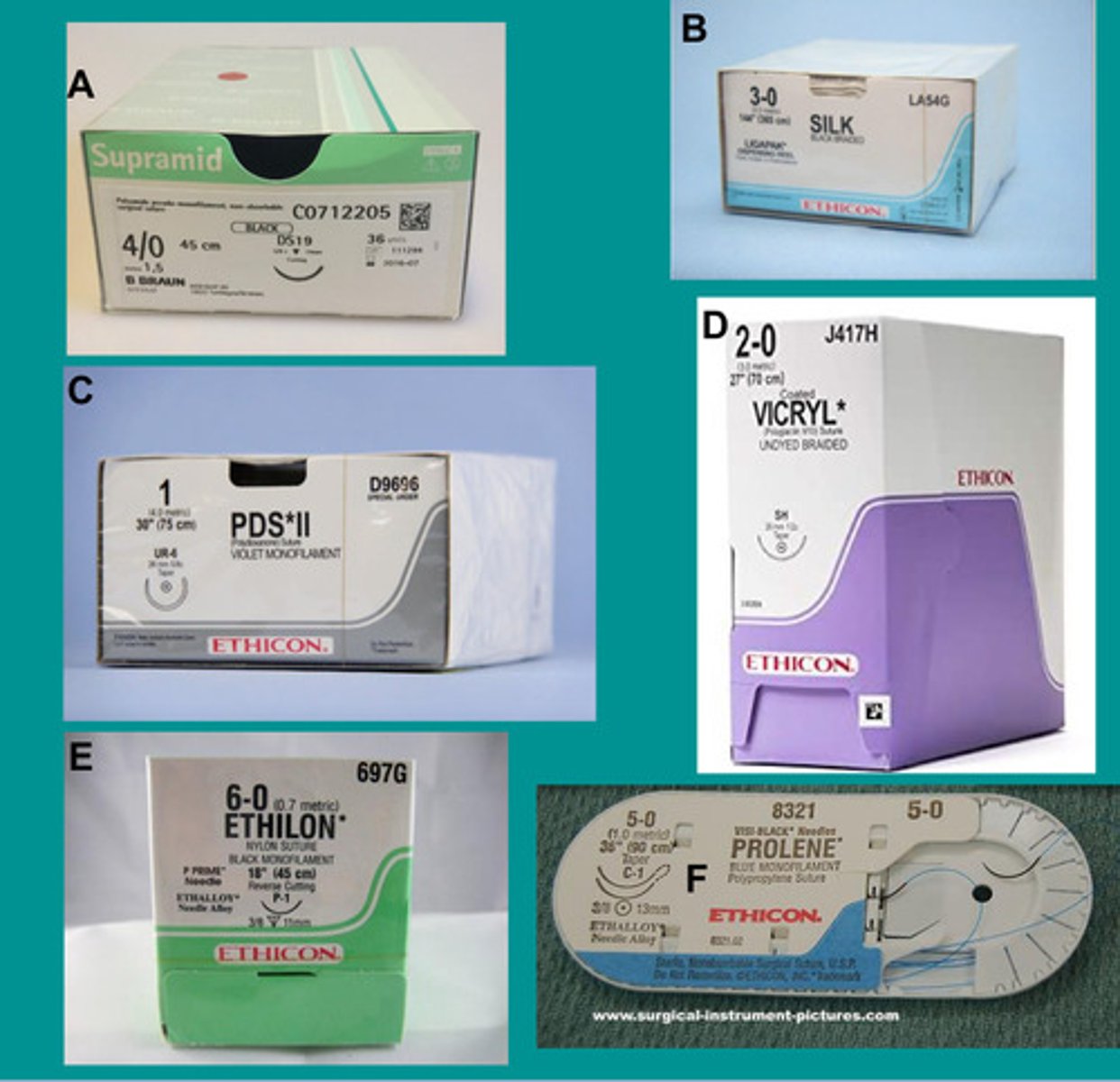
Which f them are non-absorbable?
A, B, E, F
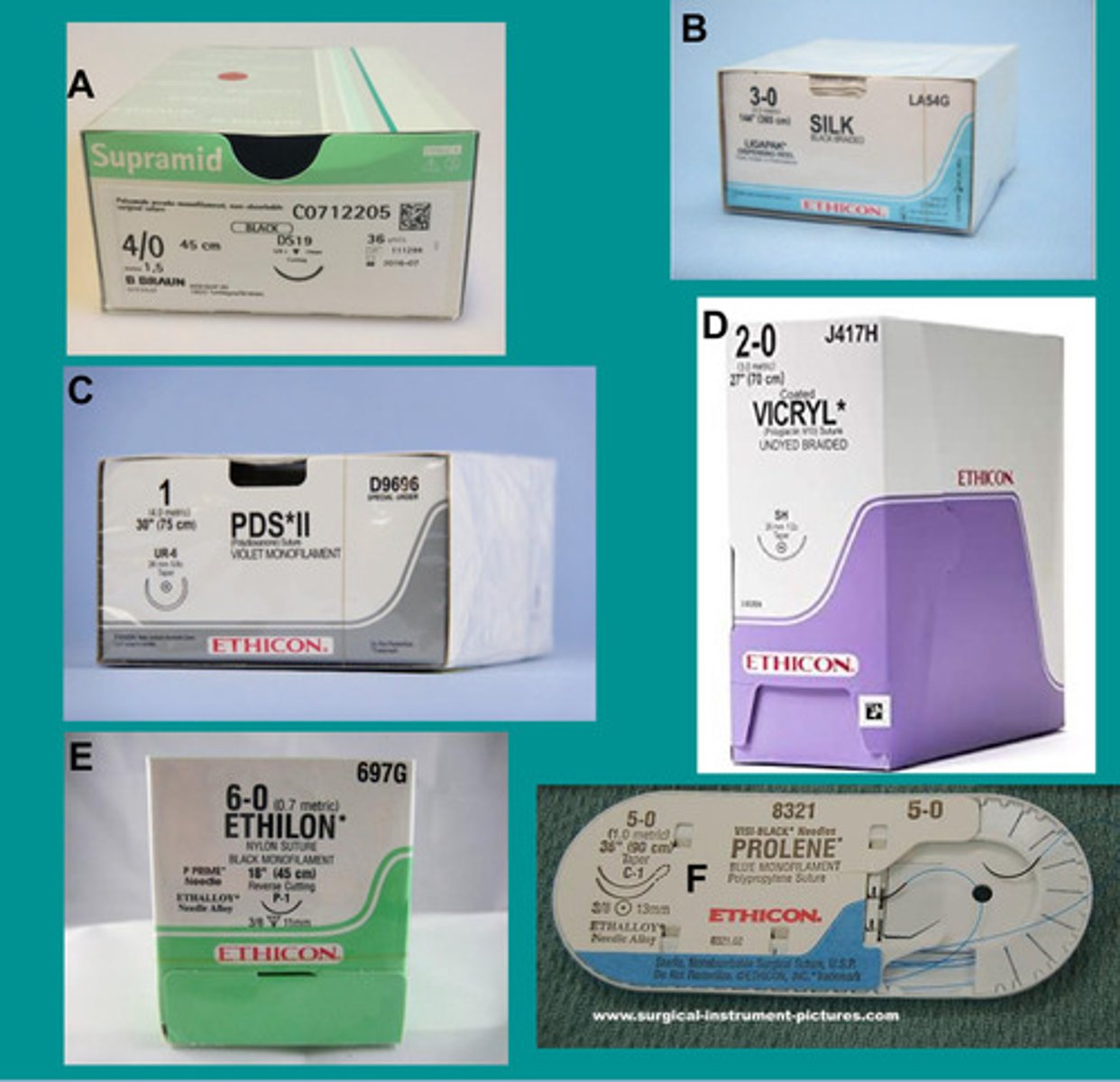
10-0 --> 8-0 Suture in SA uses
Microvascular
Corneal
7-0-->5-0 Suture in SA uses
Opthalmic, Neural, Vascular
4-0-->3-0 Suture in SA uses
Skin and Subcutis
Bowel
Bladder
2-0-->0 Suture in SA uses
Abdominal Fascia
Stomach
Hernia
1-2 Suture in SA uses
Rib Retention
Cutaneous Stents
7-0-->3-0 Suture in LA uses
Opthalmic
3-0-->2-0 Suture in LA uses
Subcutaneous tissue
Intestinal anastomosis
Skin
0-->1 Suture in LA uses
Body wall in smaller Large animals
Skin
1--3 Suture in LA uses
Body wall in larger Large animals
Skin in cattle
>3 Suture in LA uses
Specialized applications (Tie-Back Prosthesis in horse)
Taper needle are used for tissue that is ____ to penetrate such as ____ or _______ _______. They are designed to ______ tissue rather than ____ it. Never use a taper needled to suture _____ because you will _____/____ the needle.
Taper needles are used for tissue that is easy to penetrate such as bowel or blood vessels. They are designed to separate tissue rather than cut it. Never use taper needle to suture skin, because you will bend/break it!
Cutting needles have tips that are ____ in shape, which allows _____ of _____ tissue such as _____ or _____ in larger animals. Never use a ____ needle in friable tissue like ____, as you will _______ it too much.
Cutting needles have tips that are in a triangular shape which allows penetration of tough tissue such as linea alba or skin in larger animals. Never use a taper cutting needle in friable tissue like bowel, as you will damage it too much
Conventional cutting needles have the cutting edge of the needle faced ____ or ______, meaning the cut is directed _____ the incision. This type of needle is commonly called a ____ needle.
Conventional cutting needles have the cutting edge of the needle faced up or forward, meaning the cut is directed toward the incision. This type of needle is comonly called a cutting needle.
Reverse cutting needles have the cutting surface facing _____. this may decrease the likelihood of sutures _________ __________ tissue into the incision in some cases.
Reverse cutting needles have the cutting surface facing down. This may decrease the likelihood of sutures tearing through tissue into the incisons in some cases.